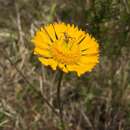Comments
provided by eFloras
The name Helenium nuttallii A. Gray is illegitimate; it has been applied to plants treated here as H. vernale.
- license
- cc-by-nc-sa-3.0
- copyright
- Missouri Botanical Garden, 4344 Shaw Boulevard, St. Louis, MO, 63110 USA
Description
provided by eFloras
Perennials, 30–80 cm. Stems usually 1, usually unbranched distally, weakly winged, glabrous proximally, glabrous or sparsely hairy distally. Leaves usually glabrous, rarely sparsely hairy; basal blades obovate to narrowly oblanceolate, usually entire or undulate to un-dulate-serrate; proximal and mid blades usually narrowly lanceolate to narrowly oblanceolate, usually entire, sometimes toothed; distal blades lance-linear, entire. Heads 1(–3) per plant, usually borne singly. Peduncles 2–23 cm, usually glabrous, sometimes sparsely hairy. Involucres hemispheric, 10–17 × 15–27 mm. Phyllaries glabrous or sparsely hairy. Ray florets 13–30, neuter; corollas yellow, 15–21 × 5–10 mm. Disc florets 150–650(–800+); corollas yellow proximally, yellow to yellow-brown distally, 4.6–6 mm, lobes 5. Cypselae 1–1.5 mm, glabrous; pappi of usually 8 entire or lacerate, non-aristate scales 1.5–2 mm. 2n = 34.
- license
- cc-by-nc-sa-3.0
- copyright
- Missouri Botanical Garden, 4344 Shaw Boulevard, St. Louis, MO, 63110 USA
Comprehensive Description
provided by North American Flora
Helenium helenium (Nutt.) Small, Fl. SE. U. S. 1292. 1903
Leptopoda Helenium Nutt. Gen. 2: 174. 1818. Leptopoda helenioides Cass. Diet. Hist. Nat. 26: 80. 1823. Leptopoda decurrens MacBride; Ell. Bot. S. C. & Ga. 2: 446. 1S24. Leptopoda denticulata Nutt. Trans. Am. Phil. Soc. II. 7: 373. 1841. Helenium Leptopoda Wood, Bot. & Fl. 182. 1870. Helenhim Xuttallii A. Gray, Proc. Am. Acad. 9: 204. 1874. Heleniastrum Helenium Kuntze, Rev. Gen. 342. 1891.
A simple perennial, with a rootstock; stem glabrous, 3-7 dm. high, slightly winged; basal leaves several, linear or linear-oblanceolate, 1-1.5 dm. long, entire or undulate or denticulate; stem-leaves few, linear, slightly decurrent, glabrous; heads solitary, radiate; peduncles 1-3 dm. long; bracts numerous, linear or linear-lanceolate, 5-7 mm. long, spreading; ray-flowers neutral, numerous; ligules yellow, 10-18 mm. long, 3 mm. wide; disk yellow, depressedhemispheric, 1.5-2 cm. broad; corollas 4.5 mm. long; tube 0.5 mm. long; achenes 1 mm. long, glabrous; squamellae 6-8, 1.5-2 mm. long, ovate, erose.
Type locality: Open swamps of Carolina. Distribution: South Carolina to Florida and Louisiana.
- bibliographic citation
- Per Axel Rydberg. 1915. (CARDUALES); CARDUACEAE; HELENIEAE, TAGETEAE. North American flora. vol 34(2). New York Botanical Garden, New York, NY
Comprehensive Description
provided by North American Flora
Helenium vernale Walt. Fl. Car. 210. 1788
Leptopoda puberula T. & G. Fl. N. Am. 2: 387, mainly. 1842. Not L. puberula MacBride. 1824. Heleniastrum vernale Kuntze, Rev. Gen. 342. 1891.
A simple perennial; stem 3-6 dm. high, more or less puberulent or shortvillous, striate, scarcely winged; basal leaves oblanceolate or spatulate, 5-10 cm. long, 1-2.5 cm. wide, not fleshy, more or less puberulent, entire or undulate, rarely denticulate ; stem-leaves lanceolate, much smaller, entire; peduncles 5-15 cm. long, thickened under the involucre; head solitary; bracts lance-subulate, 5-6 mm. long, often purplish, spreading, in age recurved; ray-flowers many, neutral; ligules yellow, about 1 cm. long; disk 1.5-2 cm. broad, depressed-hemispheric; corollas 4 mm. long, glandular-puberulent; tube very short; achenes 1.5-2 mm. long, hirsutulous on the ribs; squamellae oblong, erose.
Type locality: Carolina. Distribution: Carolina to Florida.
- bibliographic citation
- Per Axel Rydberg. 1915. (CARDUALES); CARDUACEAE; HELENIEAE, TAGETEAE. North American flora. vol 34(2). New York Botanical Garden, New York, NY
Helenium vernale
provided by wikipedia EN
Helenium vernale is a North American species of flowering plant in the aster family known by the common name Savanna sneezeweed or spring sneezeweed. It is native to the southeastern United States, from Louisiana to the Carolinas.[2]
Helenium vernale is a perennial herb up to 80 cm (31.5 in) tall, with small wings running down the sides of the stem. One plant generally produces only 1–3 hemispherical flower heads, each on its own flower stalk. Each head can contain up to 800 minuscule disc flowers, each 4.6–6.0 mm (0.18–0.24 in) across, yellow at the base, yellow or yellow-brown near the tips. There are also 13–30 yellow ray flowers.[3]
References

- license
- cc-by-sa-3.0
- copyright
- Wikipedia authors and editors
Helenium vernale: Brief Summary
provided by wikipedia EN
Helenium vernale is a North American species of flowering plant in the aster family known by the common name Savanna sneezeweed or spring sneezeweed. It is native to the southeastern United States, from Louisiana to the Carolinas.
Helenium vernale is a perennial herb up to 80 cm (31.5 in) tall, with small wings running down the sides of the stem. One plant generally produces only 1–3 hemispherical flower heads, each on its own flower stalk. Each head can contain up to 800 minuscule disc flowers, each 4.6–6.0 mm (0.18–0.24 in) across, yellow at the base, yellow or yellow-brown near the tips. There are also 13–30 yellow ray flowers.
- license
- cc-by-sa-3.0
- copyright
- Wikipedia authors and editors

